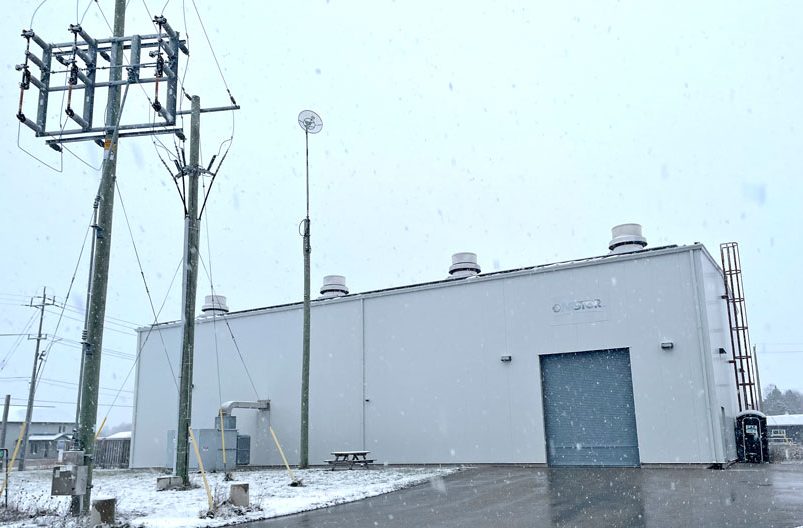MINTO – Council here has passed a resolution indicating the town’s support for plans by NRStor Inc. to upgrade its groundbreaking energy storage facility in Harriston.
The resolution was approved following a presentation by officials of the Mississauga-based company at the Dec. 20 meeting.
NRStor currently operates a flywheel energy storage and solar generation facility in the Harriston Industrial Park and intends to bid on a contract with the Independent Electricity System Operator (IESO) to supply additional storage capacity using lithium battery technology.
In 2014 the company opened a two-megawatt flywheel energy storage system on a one-acre lot in the industrial park.
The technology provides on-demand capacity similar to technologies like gas-fired generators. The stored energy is applied to the IESO grid as needed to help balance the intermittent nature of emerging renewable technologies.
The facility was the first grid-connected commercial flywheel facility in Canada.
In 2021, NRStor added a 50kW rooftop solar array to complement the flywheel energy storage system, creating the first such hybrid facility in Ontario.
NRStor’s contract with the IESO for the flywheel facility is currently set to expire in early 2023.
At the same time, the IESO has identified a large need for energy storage in Ontario and is launching a procurement process to secure up to 2,500MW of new energy storage projects in the province.
The company plans to enter an RFP for the project, which should be completed by the end of February, with the target of launching commercial operations between May 1, 2025 and May 1, 2026.
The new battery project would be under a 20-plus year contract with the IESO to provide services until April 2047.
“Energy storage is basically what it sounds like, storing electricity when it’s not needed and then putting it back onto the electricity grid when it is needed,” explained NRStor director of development and partnerships Shivani Chotalia.
“The reason that’s important is as, in Ontario and across the world really, we shift towards lower-carbon energy systems, being able to balance all these new renewable energy resources, and even optimizing the existing resources we have on the grid.”
Chotalia told council the proposed project would help address a lack of capacity in the province’s energy grid.
“As the province is looking at the energy needs across Ontario, there’s a lot of load growth and … some of the nuclear facilities and others may be coming offline. So they’ve identified a large need for what’s called capacity now,” Chotalia stated.
“And what that capacity services is a little bit different than the frequency-regulation service we’ve been doing with the flywheels.
“It’s a minimum of four hours of availability that’s needed for providing energy to the grid during certain hours of the day when everybody’s turning on lights and needing using to using the electricity on the system.”
She continued, “What we’re looking at doing in Minto is expanding our flywheel facility to incorporate lithium-ion batteries.
“And lithium-ion batteries are able to provide that capacity service the system is now looking for. So the new project … would essentially be adding battery containers to the site.”
Chotalia said if a project has municipal council support, “it can it can gain a few extra points in the RFP process and essentially be a bit more competitive.
“Because of that, we’re here today to ask for all of your support for this potential expansion at the Minto site,” she said.
Chotalia also noted the company recognizes a statement of support “does not circumvent … building permits or other permitting processes that we would need to go through.”
Councillor Ron Elliott asked what would happen to the existing flywheel operation at the site if the company is not successfully in its bid for the new project.
Chotalia said the company is looking at the existing operation separately from the RFP process.
“Our objective is to renegotiate that contract and be able to keep those flywheels running,” she said noting that if successful in the RFP process, NRStor would place the battery containers outside of the existing building.
Deputy mayor Jean Anderson asked if there were any biohazards or safety issues associated with the battery storage operation and what happens to the batteries once they are no longer functional.
It’s a 20-year contract … and so we want the batteries to be able to operate for 20 years,” said Chotalia, who conceded the batteries degrade over time.
“We monitor the the health of those batteries,” and switch out battery cells to maintain “the ability to provide those services to the grid for the full 20-year life of the facility,” she explained.
Chotalia said NRStor works with its vendors on recycling programs.
“So at the end of life, being able to take those batteries back and recycle those batteries is the objective,” she said.
“It’s been shown that it is possible to recycle, I think, more than 90% of the materials in the batteries, which is which is great.
“I wouldn’t say that the commercial processes are able to do that yet … but that’s certainly our objective.”
Council approved a resolution supporting the development, construction and operation of the project.
The resolution also noted the “sole purpose” is to enable the proponent to receive points and satisfy obligations under the RFP process “and may not be used for the purpose of any other form of approval in relation to the proposal.”
Chotalia told council the company is planning to hold an open house in January to provide information on the project to the public.



